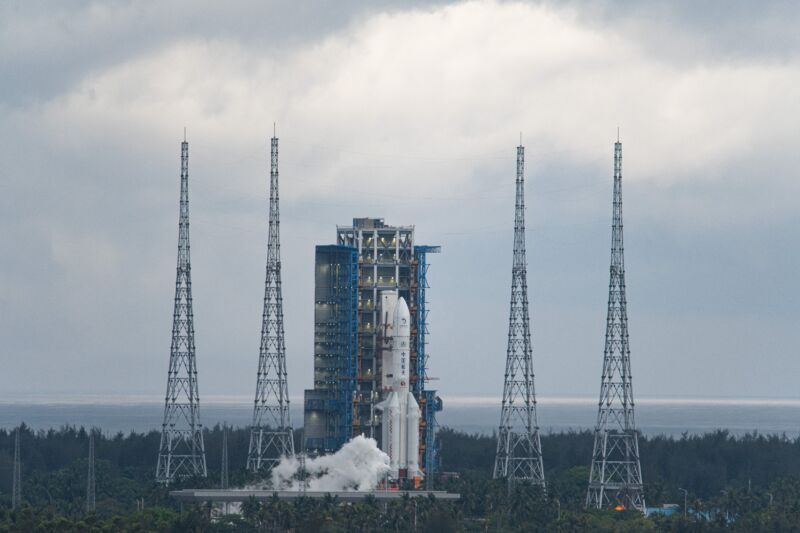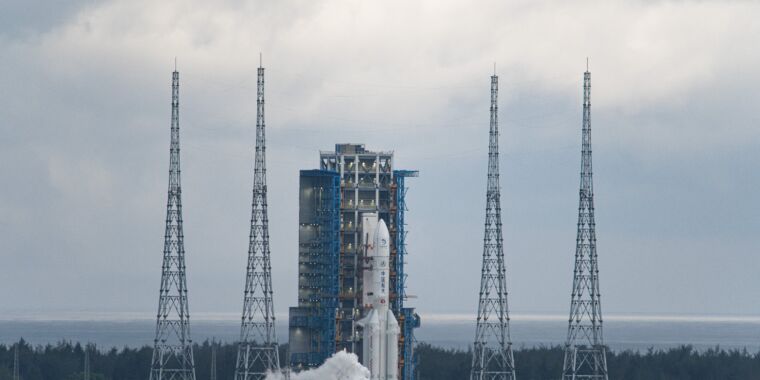NASA hasn’t landed on the Moon in decades—China just sent its third in six years

Enlarge / A Long March 5 rocket carrying the Chang’e-6 lunar probe blasts off from the Wenchang Space Launch Center on May 3, 2024 in Wenchang, China.
Li Zhenzhou/VCG via Getty Images
China is going back to the Moon for more samples.
On Friday the country launched its largest rocket, the Long March 5, carrying an orbiter, lander, ascent vehicle, and a return spacecraft. The combined mass of the Chang’e-6 spacecraft is about 8 metric tons, and it will attempt to return rocks and soil from the far side of the Moon—something scientists have never been able to study before in-depth.
The mission’s goal is to bring about 2 kg (4.4 pounds) of rocks back to Earth a little more than a month from now.
Chang’e-6 builds upon the Chinese space program’s successful lunar program. In 2019, the Chang’e-4 mission made a soft landing on the far side of the Moon, the first time this had ever been done by a spacecraft. The far side is more challenging than the near side, because line-of-sight communications are not possible with Earth.
Then, in late 2020, the Chang’e-5 mission landed on the near side of the Moon and successfully collected 1.7 kg of rocks. These were subsequently blasted off the surface of the Moon and returned to China where they have been studied since. It marked the first time in half a century, since efforts by the United States and Soviet Union, that samples were returned from the Moon.
Ambitious plans
The latest Chinese flight to the Moon launched Friday will synthesize the country’s learnings from its last two missions, by collecting and returning samples from the far side of the Moon.
“If the Chang’e-6 mission can achieve its goal, it will provide scientists with the first direct evidence to understand the environment and material composition of the far side of the moon, which is of great significance,” said Wu Weiren, an academician of the Chinese Academy of Engineering and chief designer of China’s lunar exploration program.
This mission follows the launch and deployment of the Queqiao-2 relay satellite in March, which will serve as a bridge between communications from the far side of the Moon to operators back on Earth. China has also announced two future lunar missions, Chang’e-7 and Chang’e-8, later this decade. These robotic missions will land near the lunar South Pole, test lunar resources, and prepare the way for future crewed missions.
Nominally, China’s current plan calls for the first landing of two taikonauts on the surface of the Moon in 2029 or 2030. Eventually it wants to establish a lunar outpost.
China’s lunar missions are not operating in a vacuum—OK, technically, they are—but the point here is that China’s exploration efforts are proceeding alongside a parallel effort by the United States, NASA, and about three dozen partners under the auspices of the Artemis program.
Can NASA compete?
After decades of focusing its exploration efforts elsewhere, NASA finally turned back to the Moon about seven years ago. Since that time it has worked alongside the commercial space industry to develop a plan for a sustainable return to the lunar surface.
From the outside, China’s lunar program appears to be in the lead. It is difficult to argue about the string of successes with the Chang’e lunar program and the unprecedented landing on the far side of the Moon. If Chang’e-6 proves successful, that will be another strike in favor of China’s lunar program.
But to its credit, NASA is not simply seeking to replicate the glories of its Apollo lunar program in the 1960s and early 1970s. China’s first lunar mission with astronauts, for example, is intended to land two taikonauts on the Moon for just a few hours. The vehicles will be fully expendable, as were the Apollo rockets and spacecraft more than half a century ago.
NASA is taking a different approach, working with industry to develop a fleet of commercial cargo landers—such as Intuitive Machines’ largely successful Odysseus mission earlier this year—as well as larger human landers built by SpaceX and Blue Origin. This overall “architecture” is far more complex, requiring myriad launches to refuel spacecraft in orbit. It will likely take several years longer to get to the first lunar landing missions, either later this decade or earlier in the 2030s. But should NASA persist and succeed in this approach, it will open up a highway to the Moon the likes of which could only be dreamed of during the Apollo era. Imagine a flotilla of spacecraft going to and from the Moon. That’s the vision.
So it’s a competition between China’s embrace of a traditional approach versus NASA’s efforts to open the way into some kind of new future. Watching how this lunar competition unfolds over the next decade will be one of the most fascinating stories to follow.
NASA hasn’t landed on the Moon in decades—China just sent its third in six years Read More »
